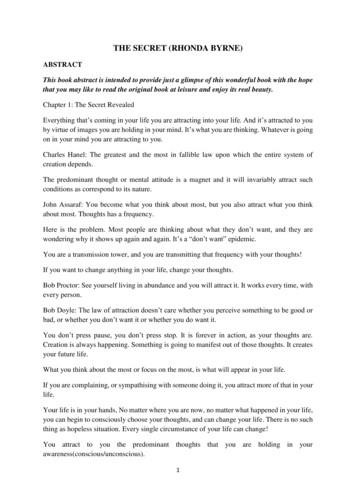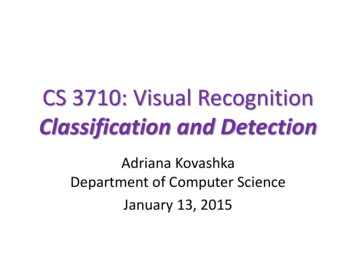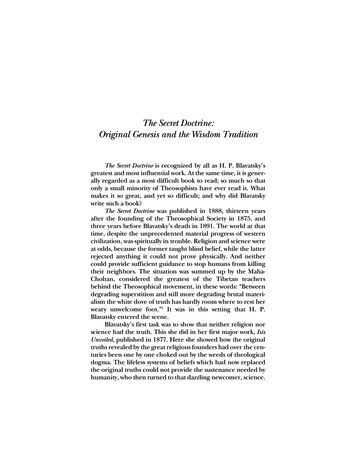
Transcription
PratyabhijnahrdayamThe Secret of Self -RecognitionJ A I D E V AS I N G H
By the same author:VIJNANABHAIRAVAORDivine ConsciousnessA classical treatise of yoga practices and philosophy accordingto the Kashmir tradition of Saivism. Vijnanabhairuva is a verya n c i e n t book on Yoga. It studiously eschews mechanicalworship, external rites and ceremonies and goes directly tothe heart of the p r o b l e m of the union of h u m a nconsciousness with the Divine. It describes 112 types of yoga.For this purpose, it makes full use of all the aspects of h u m a nlife - prana, manas, imagination and intuition.SPANDA-KARIKAST h e Divine Creative PulsationThis work elaborates the dynamic side of consciousness andserves as a c o m m e n t a r y on the Siva Sutras. According toSaivagama, the Divine Consciousness is not simply cold, inertintellection. It is rather spanda, active, dynamic, throbbingwith life, creative pulsation.SIVA SUTRAST h e Yoga o f S u p r e m e IdentitySiva Sutras are considered to be a revealed book of the Yoga:S u p r e m e identity of the individual self with the Divine. Along introduction, together with an abstract of each sutra,throws a flood of light on the entire system of Saiva Yoga.MOTILAL BANARSIDASSP U B L I S H E R S PVT. L T D .Delhi(INDIA)E-mail: mlbd@vsnl.comWebsite: www.mlbd.comRs. 150Code: 0323x
This little work is a digest of the Pratyabhijnasystem of Kashmir Saiva philosophy,prepared by Ksemaraja, the illustriousdisciple of Abhinavagupta. It avoids allpolemics and gives in a very succinct form(20 surras) the main tenets of the Pratyabhijnapresented by Utpala. Pratyabhijna meansrecognition. Jiva is Siva; by identifyinghimself with his body, Jiva has forgotten hisreal nature. This teaching is meant to enableJiva to recognise his own real self i.e., Sivaand to suggest to him the spiritual disciplineneeded to attain 'at-one-ment' with SlVA.Dr. Jaideva Singh has considerablyrevised and enlarged his translation, andprovided a scholarly Introduction, Notes,Glossary of technical terms and Indexes. Itserves as the best introduction toPratyabhijna philosophy.Pratyabhijnahrdayam
JAIDEVA SINGH (1893-1986) was a great scholarin musicology, philosophy and Sanskrit. Aformer principal of Y.D. College, Lakhimpurkheri, he also acted as a Chairman ofU . P . Sangit N a t a k A c a d e m y . H e wasawarded Padma Bhushan by theGovernment of India in 1974. His otherworks include: Siva-Sutras, Spanda Karika,Pratyabhijnahrdayam,Vijiianabhairava.
B Y T H E SAME A U T H O RT H E CONCEPTION OF BUDDHIST NIRVANAAN INTRODUCTION TO MADHYAMAKA PHILOSOPHYSIVA-SUTRAS: T H E YOGA OF SUPREME IDENTITYSPANDA-KARIKAS: T H EDIVINECREATIVE PULSATIONPARATRlSIKA-VIVARANA BY ABHINAVAGUPTAVlJNANABHAIRAVA OR DlVINE CONSCIOUSNESS
PratyabhijnahrdayamThe Secret of Self-recognitionSanskrit Text with English TranslationNotes and IntroductionJAIDEVA SINGHMOTILAL BANARSIDASS PUBLISHERSPRIVATE LIMITED DELHI
Reprint: Delhi, 1987,1991,1998, 2003-2006Fourth Revised Edition: 1982Third Revised Edition: 1980Second Edition: 1977First Published: 1963C MOTILAL BANARSIDASS PUBLISHERS PVT. LTD.All Rights Reserved.ISBN: 81-208-0322-1 (Cloth)ISBN: 81-208-0323-x (Paper)MOTILAL BANARSIDASS41 U.A. Bungalow Road, Jawahar Nagar, Delhi 110 0078 Mahalaxmi Chamber, 22 Bhulabhai Desai Road, Mumbai 400 026236, 9th Main III Block, Jayanagar, Bangalore 560 011203 Royapettah High Road, Mylapore, Chennai 600 004Sanas Plaza, 1302 Baji Rao Road, Pune 411 0028 Camac Street, Kolkata 700 017Ashok Rajpath, Patna 800 004Chowk, Varanasi 221 001Printed in IndiaBYJAINENDRA PRAKASHJAIN ATSHRIJAINENDRA PRESS,A-45 NARAINA, PHASE-I, NEW DELHI 110 028AND PUBLISHED BYNARENDRA PRAKASHJAIN FORMOTILAL BANARSIDASS PUBLISHERS PRIVATE LIMITED,BUNGALOW ROAD, DELHI 110 007
Dedicated With ProfoundRespects toSWAMl LAKSMANA J O OTo Whom Alone I OweWhatever Little I Know ofPratyabhijna Philosophy
PREFACE TO THE FOURTH EDITIONIn this edition misprints occurring in the previous editionhave been corrected.Alteration in the text of the translation has been made at afew places for the sake of greater clarity.The notes have been improved upon at a few places.Varanasi1982JAIDEVA SINGH
PREFACE TO THE SECOND EDITIONIn this edition, both the Introduction and Notes havebeen considerably enlarged.In the Introduction, three new topics, viz., Svatantryavada and Abhasavada, Sadadhva and Comparison and Contrastwith Sarhkara's Advaitavada have been added. Considerablenew additions have been made in the Notes.At some places, alteration has been made in the transla tion of the text for the sake of greater clarity.With these additions and alterations, the book has beengreatly improved and will, it is hoped, be of considerablevalue to the readers.VARANASIJAIDEVA SINGH1977PREFACE TO THE T H I R D EDITIONIn this edition, a few misprints that had crept in havebeen corrected.Alteration in the translation of the text has been madeat two or three places for the sake of greater clarity.The whole book has been thoroughly revised.Varanasi1980JAIDEVA SINGH
PREFACETOTHE.FIRSTEDITlON.Pratyabhjinahrdayam serves as the best introduction to thePratyabhijna philosophy of Kashmir. An English translationof the book by Prof. K.F. Leidecker is already available. Myonly apology for bringing out another translation of the bookis that the one that is available bristles with mistakes, some ofwhich are quite serious. It has been my painful duty to pointout a few of the serious mistakes. No one who has not studiedthis book with a teacher can work away its translation merelywith the assistance of a lexicon and grammar. I had the goodfortune of studying it with Swami Lakshman Joo who is practi cally the sole surviving exponent of this system in Kashmir,and who not only embodies within himself the tradition of theschool, but has also practised the yogic disciplines recommend ed by it. He has helped me not only by explaining the techni cal words but also in tracing out the sources of most of thequotations occurring in the book. I am deeply grateful to himfor his kind help.The Sanskrit text adopted is that of the Kashmir SanskritSeries. The translation is given below each page of the text. Itclosely follows the original - with a few words here and therein parenthesis to make the sense clearer. A person knowingeven a little of Sanskrit can follow the translation almost wordfor word. I have tried to make the translation as flawless aspossible. Some of the highly technical terms have been used init as they occur in the original, but their connotation has beenelaborately elucidated in the notes.An introduction containing the chief features of the Pratya bhijna system has been provided. An analysis of the contentsof each Sutra has also been given. Copious notes on difficultand technical words have been added, and a glossary of thetechnical terms has also been appended at the end.While the book was at the proof stage, I referred my diffi culties in some of the Sutras to MM. Dr. Gopinath Kaviraja
XPREFACE TO THE FIRST EDITIONand profited greatly by his illuminating exposition. I haveused his suggestions with advantage in some of my notes. I amdeeply grateful to him for his kind help. Acharya PanditRameshwar Jha was helpful in the clarification of some difficultpassages of the text. I, therefore, offer him my heart-feltthanks."JAIDEVA SINGH
CONTENTSPreface to the Fourth EditionviiPreface to the Second EditionviiiPreface to the Third EditionviiiPreface to the First EditionI.II.III.INTRODUCTIONix1ANALYSIS OF CONTENTS34SANSKRIT T E X T W I T H ENGLISH TRANSLATION45Notes117Glossary of Technical Terms160Sanskrit Index173English Index182
INTRODUCTION.PreliminaryThe Saiva religion is perhaps the most ancient faith of theworld. Sir John Marshall says in his Mohenjodaro and theIndus Civilization that excavations in Mohenjodaro andHarappa reveal an important fact, viz., that Sivaism hasa history going back to the Chalcolithic Age or evenfurther still, and that it thus takes its place as the mostancient living faith in the world. It had many off-shoots andappeared in different forms in many parts of the world. InIndia, there are three main forms of this religio-philosophy,viz., the Vira-Saiva form in Deccan-Kamataka, the Saivasiddhanta in Tamila Nadu, and the Advaita Saiva form inKashmir. There are some common features in all the three,but there are important differences also. Here we areconcerned with the Advaita Saiva Philosophy of Kashmir.In India, there is no such thing as arm-chair philosophy.Philosophy is not only a way of thought, but also a way oflife in this country. It is not born of idle curiosity, nor is ita mere intellectual game. Every philosophy here is a religion,and every religion has its philosophy. The philosopher herewas not a tall and spectacled professor dictating his notes tothe class or weaving cob-webs of theory in his study, but onewho was moved by a deep inner urge to know the secrets oflife, who lived laborious days of spiritual discipline and whosaw the light by the transformation of his life. Moved by pityfor his fellow-men, he tried to interpret the truth he hadexperienced to the logical reason of man. Thus arose philo sophy in this country.The Advaita Saiva Philosophy of Kashmir was of this type.For centuries, it was imparted as a secret doctrine to theaspirant who had to live it and test it in the laboratory of theSelf. In course of time only the cult and the ritual remained;the philosophical background was forgotten. Perhaps, a selectfew still knew the philosophical doctrine by oral tradition,
Pratyabhijnahrdayam2but the first thinker known to history, who reduced themain principles to writing was, Vasugupta. He is said to havelived towards the end of the eighth or the beginning of the ninthcentury A.D. Since then, philosophical writing had been anactive and continued process in Kashmir which went on fornearly four centuries. The literature on this system hasaccumulated to such an extent that it would require almost alife-time to study it. Some works of the system have still notbeen published.Saiva LiteratureThe literature of the Saiva or Trika system may be broadlydivided into t h r e e : (a) Agama Sastra, (b) Spanda Sastra,(c) Pratyabhijna Sastra.(a) Agama SastraThis is believed to be a revelation and has been handeddown from teacher to pupil. Some of the works under thisheading a r e :Malinivijaya, Svacchanda, Vijnanabhairava, Mrgendra, Rudrayamala, Siva-Sutras. On the Siva-Sutras there are the Vrtti, theVarttika of Bhaskara and Varadaraja and the Vimarsinicommentary by Ksemaraja. There are commentaries on someof the tantras also.(b) Spanda SastraThis lays down the important doctrines of the system. Themain works under this heading are :The Spanda Sutras or the Spanda Karikas. These elaboratethe principles of the Siva-Sutras. On these, there are thefollowing commentaries :Vivrti by Ramakantha, Pradipika by Utpala Vaisnava,Spandasandoha by Ksemaraja, and Spandanirnaya by Ksemaraja.Spandasandoha contains a commentary only on the first Karika.
3Introduction(c) Pratyabhijna SastraThis contains arguments and countet-arguments, discus sions, and reasonings. This interprets the main doctrines ofthe system to the logical reason of man.Somananda composed Sivadrsti. Another important workis Isvarapratyabhijna by Utpala, pupil of Somananda. Thereare the following commentaries on this :Vrtti by the author himself, Pratyabhijnavimarsini and Pratyabhijna-vivrti-vimarsini by Abhinavagupta.A digest of the Pratyabhijna Sastra, named Pratyabhijnahrdayam was prepared by Ksemaraja.Abhinavagupta's Tantraloka in 12 Volumes and hisTantralokasara give an exhaustive treatment of all the impor tant doctrines and disciplines of the system.1PratyabhijndhrdayamAs said above, this is a digest of the Pratyabhijna systemprepared by Ksemaraja. He was the brilliant pupil ofAbhinavagupta, a versatile genius who was a peerless masterof tantra, yoga, philosophy, poetics, and dramaturgy. Accord ing to Dr. K.G. Pandey, Abhinavagupta flourished in the tenthcentury A.D. Since Ksemaraja was his pupil, he must havealso lived in the tenth century. He wrote the following works :Pratyabhijndhrdayam, Spandasandoha, Spandanirnaya, Svacchandodyota, Netrodyota, Vijnanadhairavodyota, Sivasutra-vimarsini, Stavacintamanitika, Parapravesika, Tattvasandoha.Very little is known of the life and parentage of Ksemaraja.It has been very rightly said that his book, Pratyabhijnahrdayamoccupies the same place in Saiva or Trika literature asVedantasara does in Vedanta. It avoids all polemics anagives in a very succinct form the main tenets of the Pratyabhi jna system. He says at the very outset of his work :1. I am indebted to J . C . Chatterji's Kashmir Shaivism for the historicalaccount given above.
4Pratyabhijnahrdayam" I n this world, there are some devoted people who areundeveloped in reflection and have not taken pains in study ing difficult works (like Logic and Dialectics), but who never theless aspire after Samavesa with the Highest Lord whichblossoms forth with the descent of Sakti. For their sake thetruth of the teachings of ISvarapratyabhijna is being explain ed briefly."He regarded Isvarapratyabhijna of Utpalacarya as a verygreat work on this system, and has provided a ready andeasy manual for those who are inclined as a result of Divinegrace to know the main principles of 'pratyabhijna', but areunable to study the great work of Utpalacarya, because oftheir lack of training in Logic and Dialectics. He has succeed ed remarkably well in condensing in a short compass all theimportant principles of Isvarapratyabhijna and has avoidedits rigoristic logical discussion. The book is, therefore, ofsupreme importance for those who want to have an elemen tary knowledge of 'pratyabhijna'. He has composed theSutras as well as written the commentary.The word 'pratyabhijna' means re-cognition. The indivi dual Self or jiva is divine or Siva, but he has forgotten hisreal nature, and is identified with his psycho-physicalmechanism. The teaching is meant to enable him to recognisehis real nature, to bring home to him the truth that his realSelf is none other than Siva and to suggest to him the spiri tual discipline by which he can attain 'at-one-ment' with Him.The details of the teaching will be found in the body ofthe book. Here we may review the main ideas of the systemunder the following h e a d s :1. Ultimate Reality 2. The Universe or the World Process.3. Svatantryavada and Abhasavada 4. Sadadhva 5. Com parison and Contrast with Samkara's Advaitavada 6. T h eIndividual Self 7. Bondage 8. Liberation.1. Ultimate RealityReality in its ultimate aspect is Cit or Parasamvit. Cit orParasamvit is untranslatable in any other language. Generallyit is translated 'consciousness'. I have myself done so for want
Introduction5of a better word. But it should be clearly understood thatCit is not exactly consciousness. The word Con-sciousnessconnotes subject-object relation, knower-known duality. ButCit is not relational. It is just the changeless principle of allchanging experience. It is Parasarhvit. It has, so to speak,the immediacy of feeling where neither the ' I ' , nor the 'This' isdistinguished. It is the 'coalescence into undivided u n i t y ' o f' I ' and 'This'. Perhaps, the word 'sciousness' may, to someextent, express the idea contained in Git or Parasamvit. Touse the verb contained in consciousness, the Ultimate Realityor Supreme Self is the Self Sciring Itself. In the words ofPratyabhijna Sastra, it is, prakasavimarsamaya. The SupremeSelf is called Parama Siva. This is not only prakasa. T h e word'prakasa' again is untranslatable. Literally, it means light,illumination. Just as light makes every thing visible,even so that being there, every thing else is. In thewords of Kathopanisad - 'Tameva bhantam anubhati sarvam,tasya bhasa sarvamidam vibhati'. 'It shining, every thinghappens to shine. By its light alone does all this appear.'Sankara Vedanta also calls Ultimate Reality 'prakasa', butthe sun is 'prakasa; even a diamond is 'prakasa'. What is thedifference between the two? The Saiva philosophy says,"Ultimate Reality is not simply prakasa: it is also vimarsa".What is this vimarsa? This word again is untranslatable.Perhaps the word 'Sciring' may help. Ultimate Reality is notonly Sciousness (prakasa), but a Sciousness that also sciresitself (vimarsa). It is not simply prakasa lying inert like adiamond, but surveys itself. This Sciring or Surveying of itselfby Ultimate Reality is called Vimarsa. As Ksemaraja has putit in his Parapravesika (p.2) it is "akrtrimaham iti visphuran a m " ; it is the non-relational, immediate awareness of I. Whatthis 'akrtrima-aham' is, we shall see later on. If UltimateReality were merely prakasa and not also vimarsa, it would bepowerless and inert. "Yadi nirvimarsah syat anisvaro jadascaprasajyeta" [Parapravesika, p. 2) It is this pure I-consciousness orVimarsa that is responsible for the manifestation, maintenanceand reabsorption of the universe.Git scires itself as Cidrupini Sakti. This sciring itself asCidrupini Sakti is Vimarsa. Therefore, vimarsa has been named
6Pratyabhijndhrdayamdifferently as parasakti, paravak, Svatantrya, aisvarya, kartrtva,sphuratta, Sara, hrdaya, Spanda. (See Parapravesika p. 2)It will thus be seen that the Ultimate Reality is not onlyUniversal Consciousness but also Universal Psychic Energy orPower. This All-inclusive Universal Consciousness is also call ed Anuttara i.e., the Reality than which there is nothing thatmay be called higher - the Highest Reality, the Absolute. It isboth transcendental (visvottirna) and immanent (visvmaya).The Saiva philosophy has been called Realistic Idealism bysome writers. I do not think this is a happy characterizationof the Saiva philosophy. The approach of the Idealists of theWest is entirely different from that of the thinkers of the Saivaphilosophy. To characterize it in terms of the Western Idealistsis only to create confusion. The word 'idea' has played havoc inWestern philosophy, and it would not be right to import thathavoc in Saiva philosophy. Ultimate Reality is not a mere'idea' whatever that may mean, but Self underlying all reality,the Changeless Principle of all manifestation.2. Manifestation - the Universe - or the World ProcessWhether we call Ultimate Reality Sciousness or Conscious ness, it is not something blank. It has infinite powers, andcontains in a potential form all that is ever likely to be. It isthe Svabhava or nature of Ultimate Reality to manifest. IfUltimate Reality did not manifest, it would no longer beconsciousness or Self, but something like an object or not-Self.As Abhinavagupta puts i t :- Tantr. III. 100"If the Highest Reality did not manifest in infinite variety,but remained cooped up within its solid singleness, it wouldneither be the Highest Power nor Consciousness, but somethinglike a j a r " .We have seen that Ultimate Reality or Parama Siva is'prakasa-vimars'amaya In that state the ' I ' and the 'This' are inan undivided unity. The 'V is the 'prakasa' aspect, and the
Introduction7' T h i s ' o r Its consciousness of It as itself is the 'vimarsa'aspect.This Vimarsa is Svatantrya, Absolute will or Sakti. This Saktihas been called as 'the Heart of the Supreme Lord' in Parapravetika by Ksemaraja (hrdayam paramesituh). But Sakti is onlyanother aspect of the Supreme Self. In the Supremeexperience, the so-called 'This' is nothing but the Self. Thereis one Self experiencing Itself. This Vimarsa or Sakti is notcontentless. It contains all that is to be.- Paratrimsika 24"As the great banyan tree lies only in the form of potencyin the seed, even so the entire universe with all the mobileand immobile beings lies as a potency in the heart of theSupreme".Another example that is usually given is that of thepeacock. Just as a peacock with all its variegated plumagelies as a mere potency in the plasma of its egg, even so theentire universe lies in the Sakti of the Supreme. The Saktiof the Supreme is called Citi or para-Sakti or para-vak.Parama Siva has infinite Sakti, but the following five maybe considered to be the main o n e s :1. Cit - the power of Self-revelation by which the Supremeshines by Himself. In this aspect the Supreme is known as Siva.2. Ananda - This is absolute bliss. This is also calledSvatantrya - absolute Will which is able to do anything with out any extraneous aid. (Svatantryam anandasaktih : Tantrasara-Ahn. 1). In this aspect, the Supreme is known as Sakti.In a sense Cit and ananda are the very svarupa (nature) of theSupreme. The rest may be called His Saktis.3. Iccha - the Will to do this or that, to create. In thisaspect, He is known as Sadasiva or Sadakhya.4. Jnana - the power of knowing. In this aspect, He isknown as ISvara.5. Kriya - the power of assuming any and every form(Sarvakarayogitvam Kriyasaktih : Tantrasara Ahn. l ) . I n thisaspect, He is known as Sadvidya or Suddha Vidya.
8PratyabhijnahrdayamThe Universe is nothing but an opening out (unmesa) orexpansion (prasara) of the Supreme or rather of the Supremeas Sakti.I. The Tattvas of the Universal Experience: 1-5We have seen that Parama Siva has two aspects, viz.,transcendental (visvottirna) and immanent or creative (visvamaya). This creative aspect of Parama Siva is called Siva tattva.(1) Siva tattva* is the initial creative movement (prathamaspanda) of Parama Siva. As has been said in Sattrimsat-tattvasandoha:- verse 1When Anuttara or The Absolute by His Svatantrya or Abso lute Will feels like letting go the Universe contained in Him, thefirst vibration or throb of this Will is known as Siva.(2) Sakti tattva is the Energy of Siva. Sakti in her jnanaaspect is the principle of negation (nisedha-vyapara-rupa). Sakti,at first, negates the 'This' or the objective side of experience in Siva.The state in which objectivity is negated is called the very void.In Cit or Para Samvit, the 'V and the 'This' are in anindistinguishable unity. In Siva tattva, the 'This' is withdrawnthrough the operation of Sakti tattva, so that the 'I' side of theexperience alone remains. This state is called Anasrita-Siva byKsemaraja. As he puts i t :Siva in this state appears a mere ' I ' devoid of any objectivecontent. In order that Siva may appear as the Universe, abreak in the unitary experience becomes a necessary phase.But this is only a passing phase. To the Subjectivity disengag ed from the objective content, the Universe is presented again* The word 'tattva' is untranslatable, It means the 'thatness' of a thing.The nearest English word is 'principle'.
Introduction9not as an indistinguishable unity but, an "I-This" in whichboth are distinguishable but not separable, as they form partof the same Self.Sakti polarizes Consciousness into Aham and Idam (I andThis) - subject and object.Sakti, however, is nothing separate from Siva, but is SivaHimself in His creative aspect. She is His Aham-vimarsa(I-consciousness), His unmukhata - intentness to create. AsMahesvarananda puts it beautifully in his Maharthamanjari(p. 40, Trivandrum E d i t i o n ) :" H e (i.e., Siva) Himself full of joy enhanced by the honey ofthe three corners of his heart, viz., Iccha or Will, j n a n a orKnowledge, Kriya or action, raising up His face to gaze at{His own splendour) is called Sakti".MaheSvarananda explains this further in the following words :"When He becomes intent to roll out the entire splen dour of the Universe that is contained in His heart (in agerminal form), he is designated as Sakti." Sakti is, therefore,his intentness to create.Sakti is the active or kinetic aspect of Consciousness.An idea parallel to VimarSa or unmukhata is found in theChandogyopanisad 6. 2. 1-3:At first (logically, not chronologically) there was only 'Sat'- all alone without a second. He gazed and bethought toHimself "May I be many, may I procreate !"This Iksitrtva or Iksitakarma is parallel to VimarSa or unmukhatabut the implications of this Iksitakarma have not been developedby Sankara Vedanta.The Saiva philosophy does not conceive of the Supreme asa logomachist but as an Artist. Just as an artist cannot containhis delight within himself, but pours it out into a song, a
10Pratyabhijnahrdayampicture or a poem, even so the Supreme Artist pours out thedelightful wonder of His splendour into manifestation or crea tion. Ksemaraja gives expression to the same idea in hiscommentary on Utpaladeva's Stotravali :"Sakti thrown up by delight lets Herself go forth into mani festation."All manifestation is, therefore, only a process of experienc ing out, creative ideation of Siva.In Sakti tattva, ananda aspect of the Supreme is predomi nant.Siva and Sakti tattvas can never be disjoined; they remainfor ever united whether in creation or dissolution - Siva as theExperiencing Priniciple, experiencing Himself as pure-'I', andSakti as profound bliss. Strictly speaking, Siva-Sakti tattva isnot an emanation or abhdsa, but the Seed of all emanation.3.Saddtiva or Sadakhya TattvaThe will (Iccha) to affirm the 'This' side of the 'UniversalExperience is known as Sadasiva Tattva or Sadakhya Tattva. InSadaSiva, Iccha or Will is predominant. The experience ofthis stage is I am. Since 'am' or 'being' is affirmed in thisstage, it is called Sadakhya Tattva ('Sat' meaning 'being') but'am' implies 'this' (I am, but 'am' what ? - I am 'this'). Theexperience of this stage is, therefore, 'I am this', but the'this'is only a hazy experience (asphuta). The predominantside is still ' I ' . The Ideal Universe is experienced as anindistinct something in the depth of consciousness. That iswhy this experience is called 'nimesa.T h e ' T h i s ' (Idam) is faintly experienced by ' I ' (Aham) as apart of the One Self; the emphasis is however, on the T sideof experience. The 'This' (Idam) or the universe at this stageis like a hazy idea of the picture that an artist has at theinitial stage of his creation. Rajanaka Ananda in his Vivaranaon Sattrimsat-tattvasandoha very rightly says :( p . 3)
Introduction11" I n that stage, the 'This' side of the Experience is hazylike a picture of an artist which is about to be portrayed andhence which is still in an ideal state (i.e., in the state of anidea). Hence in this state it is Will that is predominant."That is why Ksemaraja says in his Pratyabhijnahrdaya :i.e., the Universe in Sadasiva tattva is asphuta or hazy dominat ed by a clear consciousness of ' I ' . Sadasiva tattva is the firstmanifestation (abhasa). For abhasa or manifestation, there mustbe aperceiver or knower and perceived or known i.e., a subjectand an object. In this universal condition, both are bound tobe Consciousness, for there is nothing else than Consciousness.Consciousness in this aspect becomes perceptible to Itself;hence a subject and an object.4. Isvara or Aisvarya TattvaThe next stage of the Divine experience is that where Idam- the 'This' side of the total experience becomes a little moredefined (sphuta). This is known as Isvara Tattva. It is unmesa ordistinct blossoming of the Universe. At this stage, jnana orknowledge is predominant. There is a clear idea of what is tobe created. Rajanaka Ananda says in his Vivarana :"As at this stage, the objective side of Experience, the'This' or the Universe is clearly defined, therefore jnana-saktiis predominant."Just as an artist has at first a hazy idea of the picturehe has to produce, but later a clearer image of the picturebegins to emerge in his view, even so at the Sadasivastage, the Universe is just a hazy idea, but at the Isvarastage, it becomes clearer. The experience of Sadasiva is "I amthis". The experience of Isvara i s : ''This am I."5. Sadvidya or Suddhavidya TattvaIn the Sadvidya tattva, the 'I' and the 'This' side ofExperience are equally balanced like the two pans of an evenlyheld balance (samadhrtatulaputanyayena). At this stage, KriyaSakti is predominant. The ' I ' and 'This' are recognised in this
12Pratyabhijnahrdayamstate with such equal clarity that while both ' I ' and 'This'are still identified, they can be clearly distinguished inthought. The experience of this stage may be called diversityin-unity bhedabhedavimarsanatmaka) i.e., while the'This' is clearlydistinguished from 'I', it is still felt to be a part of t h e ' I ' orSelf. Both ' I ' and 'This' refer to the same thing (i.e., theyhave samanadhikaranya).In Siva tattva, there is the I-experience (Aham vimarSa); inSadasiva, there is I-This experience (Aham-idam vimarsa); inIsvara tattva, there is This-I experience (Idamaham vimarSa). Ineach of these experiences, the emphasis is on the first term.In Suddhavidya tattva, there is equal emphasis on both. (AhamAham - Idam Idam. I am I - This is This). Since thisexperience is intermediate - between the para or the higher andapara the lower - in which there is a sense of difference, it iscalled parapara dasa.It is called Sadvidya or Suddhavidya, because at this stage thetrue relation of things is experienced.Upto this stage, all experience is ideal i.e., in the form ofan idea. Hence it is called the perfect or 'pure order'(Suddhadhvan) i.e., a manifestation in which the svarupa or realnature of the Divine is not yet veiled.II The Tattvas of the Limited Individual Experience6-11. Maya and the five KancukasAt this stage, Maya tattva begins its play. From this stageonward there is ASuddhadhvan or the order in which the realnature of the Divire is concealed. All this happens becauseof Maya, and her kancukas. Maya is derived from the root'ma', to measure out. That which makes experience measur able i.e., limited and severs ' T h i s ' f r o m ' I ' a n d ' I ' from 'This'and excludes things from one another is Maya. Upto Sad vidya, the experience was Universal; the 'This' meant 'all-this'- the total universe. Under the operation of Maya, 'this'means merely 'this' different from every thing else. From nowon starts Sankoca or limi
SIVA SUTRAS The Yoga of Supreme Identity Siva Sutras are considered to be a revealed book of the Yoga: Supreme identity of the individual self with the Divine. A long introduction, together with an abstract of each sutra, throws a flood of light on the entire system of Saiva Yoga. MOTILAL BANARSIDASS PUBLISHERS PVT. LTD. Delhi (INDIA)











